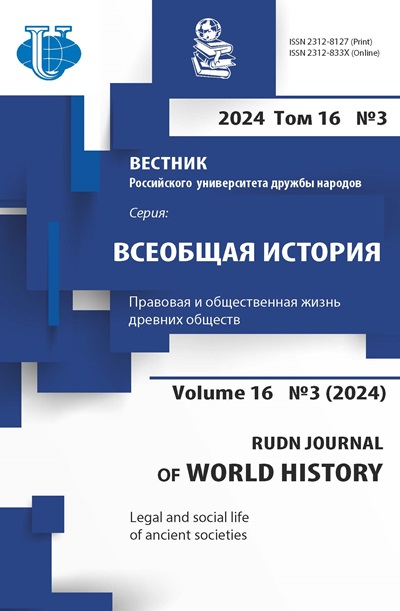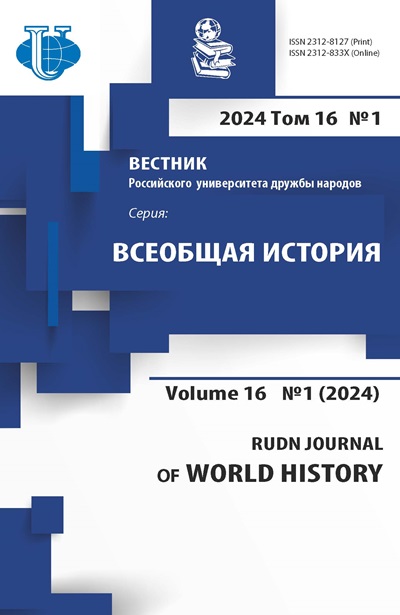Gender aspect in the ideology and practice of Iranian nationalism in the early 20th c.
- Authors: Ardashnikova A.N.1, Konyashkina T.A.1
-
Affiliations:
- Lomonosov State University
- Issue: Vol 16, No 1 (2024)
- Pages: 64-79
- Section: Ideas and politics in history
- URL: https://journals.rudn.ru/world-history/article/view/38725
- DOI: https://doi.org/10.22363/2312-8127-2024-16-1-64-79
- EDN: https://elibrary.ru/ECKNDV
Cite item
Full Text
Abstract
Iranian history is one of those rare cases when the topic of women’s social status was raised by the ruling regimes twice - in the1920-1930s and 1970s. This fact shows firm connection of nationalist and gender discourses. Since gender issues were not only declared on behalf of the state, but were also widely discussed in the public sphere, the study uses sources of an artistic and journalistic origin, that traditionally in Iran play the role of ideological indicators. These include materials from the Iranian, mainly women’s press as well as the works of the literary corpus. The examples of poster genre, which propagandizes for the position of the state and visualizes the ideology, also serve as a valuable source for the research. The undertaken study shows that, starting from the end of the 19th century, Iranian nationalism has been intensively exploiting gender issue to proclaim its own positions, using family metaphors and a system of female symbols for political purposes. As an ideology of a modernizing society, nationalism in Iran actively used the image of the “progressive Iranian woman” as a link between the present day and the great pre-Islamic past.
About the authors
Anna N. Ardashnikova
Lomonosov State University
Author for correspondence.
Email: anardash@mail.ru
ORCID iD: 0000-0001-9170-1803
Ph.D. (Literature), Associate Professor, Department of Iranian Philology, Institute of Asian and African Studies
11/1 Mokhovaya St, Moscow, 125009, Russian FederationTamara A. Konyashkina
Lomonosov State University
Email: tamara_mgu@mail.ru
ORCID iD: 0009-0002-7569-5794
senior lecturer, Department of Middle and Near East History
11/1 Mokhovaya St, Moscow, 125009, Russian FederationReferences
- Litvak M. The construction of Iranian national identity. An overview. Constructing nationalism in Iran. London — New York: Routledge, 2017. P. 10–31.
- Dekhkhoda A. Logatname [Dictionary]. Tegeran, 1994 (In Persian).
- Reza-shah Pahlavi. Safar-name-je be Huzestan va Mazandaran [Travel accounts]. USA: Ketab Corp. 2007 (In Persian).
- Tavakoli-Targhi M. Refashioning Iran. Orientalism, Occidentalism and Historiography. New York: Palgrave, 2001.
- Koraev TK. «Soyuz v rvenii», ili «Molodaya Turciya»: k istorii osmanskoj obshchestvennopoliticheskoj mysli vtoroj poloviny XIX veka [“The Union in Zeal”, or “Young Turkey”: on the history of Ottoman socio-political thought of the second half of the 19th century. Sociologicheskoe obozrenie [Russian sociological review]. 2014;13(2):33–71.
- Maragei Zejn ol’-Abedin. Dnevnik puteshestviya Ibragim-beka, ili ego zloklyucheniya po prichine fanatichnoj lyubvi k Rodine [Travel accounts of Ibrahim-bek]. M., 1963.
- Ryabov OV. Gendernoe izmerenie nacionalizma: metodologicheskie problemy issledovaniya [Gender dimension of nationalism: methodological problems of research.]. Vestnik Ivanovskogo gosudarstvennogo universiteta. Seriya «Estestvennye, obshchestvennye nauki» [Ivanovo state university bulletin. Series « Social Sciences”]. 2008;(2):42–51.
- Sur-e Esrafil. 1907 (4). Arhiv iranskoj pressy perioda mashrute. Available from: https://digitale-sammlungen.ulb.uni-bonn.de/ulbbnioa/periodical/pageview/4287107 (accessed: 22.06.2023) (In Persian).
- Najmabadi A. “Is Our Name Remembered?”: Writing the History of Iranian Constitutionalism as if Women and Gender Mattered. Iranian Studies. 1996;29(1/2):85–109.
- Rossijskij gosudarstvennyj arhiv social’no-politicheskoj istorii [The Russian State Archive of Socio-Political History, Moscow]. Fond 495, opis’ 90, delo 87. Byulleten’ Polpredstva SSSR v Persii [Bulletin of the USSR embassy in Persia]. 1923. L. 7.
- Roskosh’ zakata. Iran epohi Kadzharov. Konec XVIII v. — 1925 [The luxury of sunset. Iran in the Qajar era] Katalog vystavki. M.: GMV, 2021.
- Chajkin K.I. Kratkij ocherk novejshej persidskoj literatury [A brief outline of modern Persian literature]. M., 1928.
- Browne EG. Press and Poetry of Modern Persia: Partly Based on the Manuscript Work of Mirza Muhammad Ali Khan “Tarbiyat” of Tabriz. Cambridge, 1914.
- Constitutional revolution: The press. Available from: https://iranicaonline.org/articles/constitutional-revolution-vi (accessed: 20.06.2023)
- Danesh. 1910 (1). Arhiv iranskoj pressy perioda mashruteh. Available from: https://digitalesammlungen.ulb.unibonn.de/ulbbnioa/periodical/pageview/4125711 (accessed: 10.06.2023) (In Persian)
- Danesh. 1910 (3). Arhiv iranskoj pressy perioda mashrute. Available from: https://digitalesammlungen.ulb.uni-bonn.de/ulbbnioa/periodical/pageview/4125730 (accessed: 10.06. 2023) (In Persian)
- Smirnov KN. Zapiski vospitatelya persidskogo shaha [Accounts of the teacher of the Persian Shah]. 1907–1914 gody. Tel’-Aviv: Ivrus, 2002.
- Bachtin P. The Royal Harem of Naser al-Din Shah Qajar (r. 1848–96): The Literary Portrayal of Women’s Lives by Taj al-Saltana and Anonymous ‘Lady from Kerman’. Middle Eastern Studies. 2015;51(6):986–1009. https://doi.org/10.1080/00263206.2015.1044897
- Repina LP. Pol, vlast’ i koncepciya “razdelennyh sfer”: ot istorii zhenshchin k gendernoj istorii [Gender, power and the concept of “separated spheres”: from women’s history to gender history.] Obshchestvennye nauki i sovremennost’ [Social Sciences and Contemporary World]. 2000;(4):123–137.
- The making of modern Iran. State and society under Riza Shah, 1921–1941. Ed. Cronin S. London — New York: Routledge, 2003.
- Kazemi M. Strashnyj Tegeran [Terrible Tehran]. Perevod s pers. V.I. Tardova. Baku: Gyandzhlik, 1984.
- McClintock A. «No Longer in a Future Heaven»: Nationalism, Gender, and Race. In: Becoming National: A Reader. G. Eley, R.G. Suny (Eds). New York, 1996, p. 260–285.
- Persidskij enderun. Pis’ma iz Tegerana [Persian Anderun. Letters from Tehran]. Vestnik Evropy [Herald of Europe] 1886. № 10. S. 501–548.
- Eshki Mirzade. Kollijat-e mosavvar [The complete works]. Tegeran, 1981 (In Persian).
- Gilani Ashraf ad-Din. Kollijat-e Ashraf Gilani [The complete works of Ashraf Gilani]. Tegeran, 1996 (In Persian).
- Iradzh Mirza Dzh. Divan [Poetic works]. Tegeran, 1963 (In Persian).
- Nahid. 22 ordibiheshta 1307 g. (12 maya 1928 g.). № 68 (In Persian).
- Kireev MG. Istoriya Turcii XX vek [The history of Turkey XX c.]. M.: Kraft+IV RAN, 2007.
- Honarbin-Holliday M. Becoming Visible in Iran. London; New York: Tauris Academic Studies, 2008.
- E‘tesami P. Divan [Poetic works]. Tegeran, 1954 (In Persian.).
- Beebeejaun Y. Gender, Urban Space, and the Right to Everyday Life. Journal of Urban Affairs. 2017;39(3):323–334.
- Sрahri Dzh. Tekhran-e kadim [Old Tehran]. Tegeran: Amir-e kabir, 1979 (In Persian).













